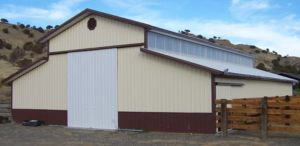Once again, we do the research, so you don’t have to!
My loyal readers will recognize I have researched some things which maybe no one will ever care about. From my perspective – if it makes a difference to even one person, then it was worth the work.
 Recently one of our clients asked for a comparison between a Hansen Pole Building, and building produced by another provider. In doing the research to be able to give the client a qualified answer, I did come across a product which I was not familiar with – Acrylit®. Acrylit is a panel which is manufactured with 100% Acrylic resin with Gel Coat protection on both sides. Acrylit panels can be used for eave and ridge lights – which allow for natural light to enter pole buildings which do not have interior finished walls or ceilings.
Recently one of our clients asked for a comparison between a Hansen Pole Building, and building produced by another provider. In doing the research to be able to give the client a qualified answer, I did come across a product which I was not familiar with – Acrylit®. Acrylit is a panel which is manufactured with 100% Acrylic resin with Gel Coat protection on both sides. Acrylit panels can be used for eave and ridge lights – which allow for natural light to enter pole buildings which do not have interior finished walls or ceilings.
For more information on eave lights: https://www.hansenpolebuildings.com/blog/2013/07/eave-light/
Hansen Pole Buildings provides CoverLite® Polycarbonate panels for use as eave lights. These panels offer a high degree of light transmittance due to its high optical properties, with up to 90% light transmission. They are economical and light weight, yet 10 times stronger than acrylic and 200 times stronger than glass! CoverLite comes with a full 10 year warranty against yellowing and a five year warranty against breakage caused by hail.
In discussions with AmeriLux (the manufacturer of CoverLite), it was found Coverlite Solar Grade Polycarbonate Corrugated will not undergo a loss in light transmission in excess of 15 (fifteen) percent in comparison with the original value when tested in accordance with ASTM D 1003 (95); will not undergo a change in excess of 15 (fifteen) delta in comparison with the original value when tested in accordance with ASTM E 313-73.
I actually read the ASTM standards referenced, and you can read ASTM D 1003 here: https://www.astm.org/Standards/D1003.htm
ASTM E313-73 Is the “Standard Test Method for Indexes of Whiteness and Yellowness of Near-White, Opaque Materials”
What really caught my attention was: Acrylic will burn/melt rather than self-extinguish like polycarbonate would.
There are lots of fires in pole buildings, adding a product which will contribute to a burn does not sound like a prudent choice to me. Add this to polycarbonate being ten times as strong as acrylic panels, and we’ve got a hands down winner!
Oh, and did I mention acrylic is more expensive? For those who care only about cost, it’s a no brainer.






